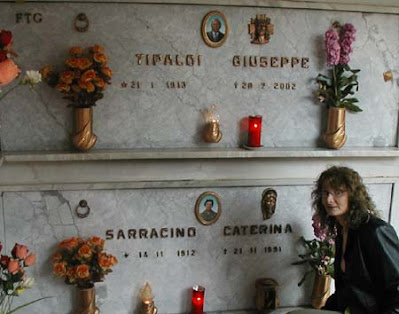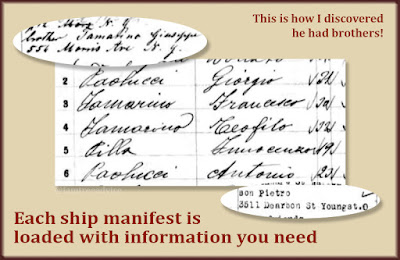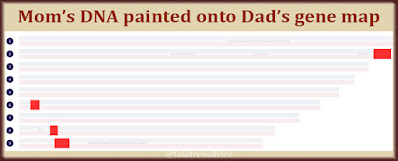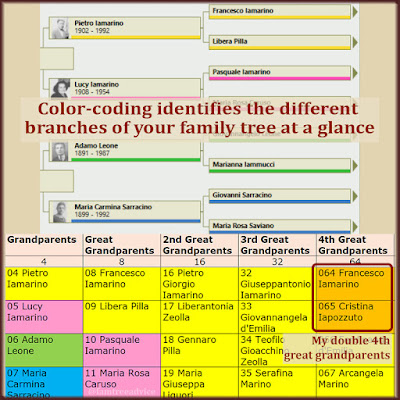Cemeteries get genealogists excited. Put that excitement to good use.
It was April 2005. As we were leaving the little town where my great grandparents were born, I spotted something.
"Stop! Go back! That was the cemetery."
What I had spotted was my 2nd great grandmother's last name peeking up above a wall. The name
Muollo, high up on a crypt, was all I could see of the cemetery.
My husband and I stepped into this very small Italian town's very small cemetery. We were looking for familiar names. And we found plenty. He took several awkward pictures of me smiling next to a grave.
We also took gravestone photos in my mother's father's hometown and my father's grandmother's hometown.
 |
| The locals were definitely looking at me funny. |
I didn't return to my ancestors' hometowns until 2018. By that time, I knew a heck of a lot more last names that belonged in my family tree. I took so many pictures that my iPhone's battery died. And it's always fully charged. I switched to my husband's phone.
A Genealogy Fan's Calling
If you get the chance to visit your ancestors' towns, remember this: As a genealogy fan you're duty-bound to visit the cemeteries. Take as many photos as you can. All those lovely gravestones are people waiting to find their way into your family tree.
And if it's also the custom where your people come from, the graves may have a photograph of the deceased. I treasure those photographs.
Once you're home again, dig up the photos and see what you can create from all those names and dates.
3 Success Stories
Here are 3 examples of random cemetery photos I took. They were people I hoped were relatives. Here's what I discovered about them.
1. Potential 1st Cousin
On the 2005 visit to that first cemetery, I knew only 3 last names from the town:
- Muollo—the name that called out to me as we were driving by the cemetery
- Sarracino
- Saviano
Just inside the gate, opposite the Muollo crypt, there were a couple of Sarracino gravestones. These were little niches built into the exterior wall of the cemetery.
We continued walking row by row, finding a Saviano and many Sarracinos. One Sarracino grave seemed to speak to me. This is my maternal grandmother's maiden name. Grandma was conceived right there in that town, but born in New York in late 1899. (She's yelling at me from beyond for not saying she was born in 1900.)
I found the grave of Vincenzo Sarracino, born in 1902. I saw the photo of his face, and I thought he looked nice. He felt familiar. Because of his name and birth year, I thought he might be my grandmother's first cousin.
 |
| Even if you don't know them now, they may be yours. |
Three years later, I found out the truth. I'd gone to Pittsburgh to meet a large group of my distant Sarracino cousins. They showed me photographs of Vincenzo Sarracino with his wife and children. His father and my grandmother's father were brothers.
Vincenzo really was my grandmother's first cousin.
2. Side-by-Side
In some countries including Italy, your remains don't stay in the grave forever. They limit the cemetery's footprint. Over time, they place the bones into small containers so many family members can occupy one space.
In my grandfather's hometown in 2018, I spotted 2 gravestones leaning against a wall. I thought the markers were recently removed from their spot and the bodies relocated.
 |
| Were they placed there randomly, or did they belong together? |
They were Angela Iamarino and Innocenzo Gentile. She had my maiden name. I wondered if the two of them belonged together.
Using my
collection of downloaded Italian vital records, I found their birth records. Angela and Innocenzo were in fact a married couple. Each of their birth records has their marriage date and their spouse's name written in the column. (I love when they do that.)
It turns out Angela's parents were already in my family tree. Angela was my great grandfather's 3rd cousin. Thanks to the gravemarker, I have her gentle face in my family tree.
3. A Kind Face
When we photographed Michelina Leone's grave in 2005, we had no idea who she was. And while my grandfather's last name of Leone is common, in his hometown, any Leone is likely related to me. And I thought she had a kind face.
A couple of years later a second cousin reached out to me from Italy. He must have found me on a genealogy board and emailed me. His grandmother was my grandfather's sister Eva Leone.
He told me Eva's sad story—which no one in my family in America had ever heard. Eva was 49 years old, working as a housekeeper in someone else's home. One day she decided to take a little drink of what she thought was wine.
It was poison. Despite it being 1947, no one could get her to medical care in time, and she died.
Eva's sons were grown at the time, but not married. Michelina Leone stepped in to help out. She took care of Eva's sons and probably kept house for Eva's widower. Michelina was the daughter of Eva's first cousin, but only 6 years younger than Eva.
I visited the Leone hometown again in 2018. Thanks to a tip from a friend, I found a small plaque placed by Michelina Leone attached to one of the church pews. It's dedicated to the memory of her parents.
 |
| She honored her family—my family—in many ways. |
Now each of these people—and many more—are in my family tree. So is my photograph of their gravestone. And so is their portrait, as seen on their grave.
Small town cemeteries are bound to contain many relatives. But it isn't only small towns. I can walk the rows of St. Raymond's Cemetery in the Bronx, New York, and find a good number of relatives' names there. And they'll always be there.
What about your hometowns? The next chance you have to visit a cemetery where you know you have relatives, spread out. Photograph more and more of the gravestones. Work with the facts to see what you've found. Then share your photos on
Find a Grave,
Billion Graves, or both. It's a genealogy project that keeps on giving.
And speaking of genealogy vacations:































